The first time I used turmeric, I was cooking from a recipe for an Indian curry in the kitchen of the very first apartment I rented by myself. As I was cleaning up, I spilled some of the curry on the brand-new white linoleum. Immediately I wiped it up but it left a bright yellow spot on the floor. Eek! Terrified to lose any part of my security deposit, I grabbed the first liquid cleaner I could find. The bright yellow? Promptly turned bright purple!!
Fortunately it only took a damp washcloth to wipe away the bright purple. (whew!)
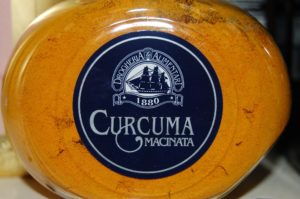
Turmeric is the hot ingredient du jour, and played a major role at Expo West in 2017 and 2018. Since I’m not a big fan of the “golden milk” flavor, I’m giving away a turmeric prize pack (more on that below), but first I thought I’d do a deep dive into the truth about turmeric.
Disclosure: I received the contents of the Turmeric Taster Prize Pack as a New Hope Blogger Co-op member. All of the content in this post is mine, and none of the brands included even know I am writing this.
Get Your Nerd On!(Or Start Scrolling)
Since I’m an attorney for my day job, let’s start by defining turmeric. In the United States, the Code of Federal Regulations, Title 21 (Food and Drugs), Part 73 (Listing of Color Additives Exempt from Certification), Subpart A (Foods) defines turmeric:
(a) Identity. (1) The color additive turmeric is the ground rhizome of Curcuma longa L. The definition of turmeric in this paragraph is for the purpose of identity as a color additive only, and shall not be construed as setting forth an official standard for turmeric under section 401 of the act. [Bain: Section 401 of the Federal Food, Drug, and Cosmetic Act is “Definitions and standards for food.”]
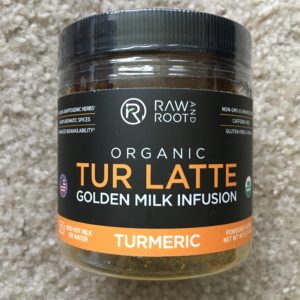
(2) Color additive mixtures made with turmeric may contain as diluents only those substances listed in this subpart as safe and suitable in color additive mixtures for coloring foods.
(b) Uses and restrictions. Turmeric may be safely used for the coloring of foods generally, in amounts consistent with good manufacturing practice, except that it may not be used to color foods for which standards of identity have been promulgated under section 401 of the act, unless the use of added color is authorized by such standards.
(c) Labeling. The color additive and any mixtures intended solely or in part for coloring purposes prepared therefrom shall bear, in addition to the other information required by the act, labeling in accordance with the provisions of 70.25 of this chapter. [Bain: this is the labeling requirements for color additives, other than hair dyes, 21 CFR 70.25]
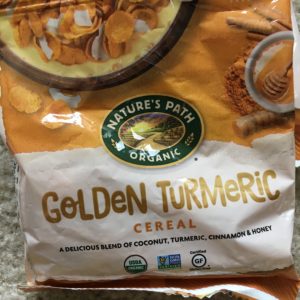
(d) Exemption from certification. Certification of this color additive is not necessary for the protection of the public health, and therefore batches thereof are exempt from the certification requirements of section 721(c) of the act. [Bain: Section 721 of the Federal Food, Drug, and Cosmetic Act is “Listing and certification of color additives for foods, drugs, devices, and cosmetics.”]
21 CFR 73.600 (revised as of April 1, 2017). There is an entire separate definition for “turmeric oleoresin” at 21 CFR 73.615 (which is “the combination of flavor and color principles obtained from turmeric by extraction using any one or a combination of” specified solvents).
Hey, this is what you get when you cross a nerd with a blogger.
If you read that and wondered what the part in (a) is about “definitions and standards for food,” here it is:
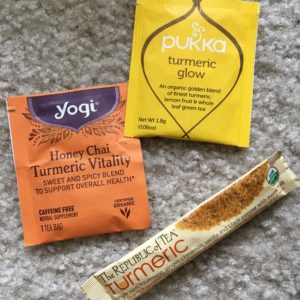
Whenever in the judgment of the Secretary such action will promote honesty and fair dealing in the interest of consumers, he shall promulgate regulations fixing and establishing for any food, under its common or usual name so far as practicable, a reasonable definition and standard of identity, a reasonable standard of quality, or reasonable standards of fill of container. No definition and standard of identity and no standard of quality shall be established for fresh or dried fruits, fresh or dried vegetables, or butter, except that definitions and standards of identity may be established for avocados, cantaloupes, citrus fruits, and melons. In prescribing any standard of fill of container, the Secretary shall give due consideration to the natural shrinkage in storage and in transit of fresh natural food and to need for the necessary packing and protective material. In the prescribing of any standard of quality for any canned fruit or canned vegetable, consideration shall be given and due allowance made for the differing characteristics of the several varieties of such fruit or vegetable. In prescribing a definition and standard of identity for any food or class of food in which optional ingredients are permitted, the Secretary shall, for the purpose of promoting honesty and fair dealing in the interest of consumers, designate the optional ingredients which shall be named on the label. Any definition and standard of identity prescribed by the Secretary for avocados, cantaloupes, citrus fruits, or melons shall relate only to maturity and to the effects of freezing. [BTW: the official version use “avocadoes” which makes me think former Vice President Quayle did the editing!]
21 USC 341. (You can find all of the nerdy goodness at http://uscode.house.gov in Title 21, Food and Drugs.)
If you don’t care about the legal stuff, start reading here.
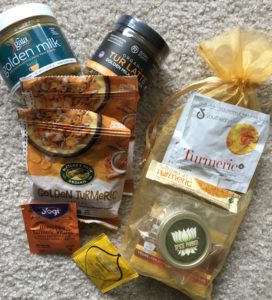
I was surprised to learn there are six different plants called “turmeric” (see the disambiguation page here https://en.wikipedia.org/wiki/Turmeric_(disambiguation) The one I care about, of course, is the gold-yellow one: curcuma longa, ”a rhizomatous herbaceous perennial plant of the ginger family, Zingiberaceae.”
In English, it’s a plant that has underground stem that sends out roots and shoots, and if you separate that piece it can become a new plant (“rhizomatous”). It does not have a permanent woody stem, but has a stem that dies at the end of the growing season like a potato or a carrot (“herbaceous”). While the stem dies at the end of the growing season, a part of the plant survives underground and the plant can grow a new stem in the next growing season (“perennial”). This means that unlike some other plants that Americans have fixated on over the years, it’s unlikely we’re going to accidentally wipe out turmeric.
Uses of Turmeric
As a plant dye, turmeric has been used to dye clothing. (Wikipedia reports it isn’t very good for that purpose as it fades in sunlight, but another site I found claims Asian monks use it to dye their robes.) Turmeric is also used as a dye in food products, as well as in cosmetic products. (According to UKfoodguide.net it is sometimes identified by E100 on labels.) You can find turmeric as a colorant and a featured ingredient in soaps, teas, cheeses, and more.
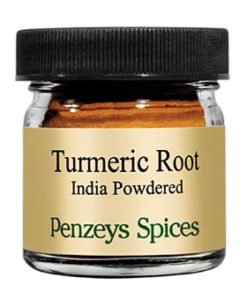
In cooking, the turmeric root is ground up and used as a flavoring. Turmeric is what makes yellow mustard yellow. It flavors and colors a variety of curries. A little turmeric in rice turns the dish yellow and adds a little flavor. If you just run a quick web search, you’ll find millions of recipes that use turmeric. (Here are a bunch from my friends at Luvo, and here is one for roasted carrots that I think looks delicious!)
The part of turmeric that does all the cool things is called curcumin. (Note this is not the same as cumin, which is an entirely different plant.) Curcumin’s chemical formula is (1,7-bis(4-hydroxy-3-methoxyphenyl)-1,6-heptadiene-3,5-dione), and it is also called diferuloylmethane; it is a polyphenol. [Hewlings/Kalman for that factoid, and for most of the rest of this paragraph.] Not all that helpfully, Wikipedia explains that polyphenols are “are a structural class of mainly natural, but also synthetic or semisynthetic, organic chemicals characterized by the presence of large multiples of phenol structural units.” Curcumin is also a curcuminoid (which has an equally unhelpful definition for those of us who are not chemistry majors). That category includes curcumin, bisdemethoxycurcumin, and demethoxycurcumin. The FDA labels curcuminoids “Generally Recognized as Safe” (GRAS), even at amounts much longer than you are ever likely to ingest (12,000/mg day).
Tasty in Curry, Questionable as Medicine?
With all the hype turmeric has gotten in the past few years, you’d think there is a bunch of science backing the effectiveness of turmeric. Nope!
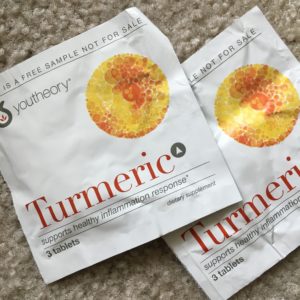
Sure, ancient people did not have microscopes and the period table, or even a basic understanding of biology (just look at the history of “hysteria”), but there wasn’t any interest in proving turmeric had health benefits until recently. Call me cynical, but that interest seems to coincide with the natural product manufacturers’ realization that adding a health claim to a turmeric product would make it much more profitable. Saying, “it tastes nice” is one thing, but if you can say “contains anti-oxidants” then you can up the price.
Ready for a total oversimplification of the science? The two main ways curcumin acts within the human body are as an antioxidant and as an anti-inflammatory. There is evidence curcumin acts to reduce markers of oxidative stress in the body. [Hewlings/Kalman] Oxidative stress and inflammation are like BFFs, and as near as I can tell from reading what’s on PubMed, one can cause the other. There is some evidence curcumin can downregulate (stop the action of) things that cause inflammation. While we’re on the topic of inflammation, that word gets tossed around WAY too much these days, especially in the fake-science and pseudoscience that is running rampant on the internet. You’ve got two ways to know you have real inflammation, and pretty much only two: one, observing something that is inflamed like a bruise or an injured body part or two, diagnostic testing by a qualified medical professional, like a blood test (other tests may be appropriate to diagnose inflammation). If you vaguely feel crummy, you can’t just magically tell inflammation is the cause or get diagnosed over the internet.
Some of the promising research on curcumin (not turmeric) has been for arthritis and the cluster of symptoms known as metabolic sydrome. The Hewlings/Kalman article has a decedent overview and summary of the state of the research up to 2017. Unfortunately, most of the research to date has been animal research, not human research; and while we have some means to logically extrapolate, the results of even well-designed animal studies do not always translate to how a substance actually works in humans.
Turmeric has been used medicinally for a long time, though until recently there wasn’t much research to support the effectiveness. While we now have additional research and data out, the health benefits of turmeric specifically, and curcumin generally, is not as rock-solid as the ads for turmeric-based products would have you believe. Even the National Center for Complementary and Integrative Health states, “Claims that curcuminoids found in turmeric help to reduce inflammation aren’t supported by strong studies.” [NCCIH]
Important Safety Tips!
Talk to your doctor or pharmacist. As with ANY supplement, herb, vitamin, or mineral you use on a regular basis: tell your doctor! If you’re interested in trying a supplement of any kind and you also take prescription medication, please talk to your doctor or pharmacist first. You’ve probably come across at least one mention of an older person who got sicker or died because they drank grapefruit juice with their medication. There is some evidence that curcumin can affect anticoagulant and antiplatelet drugs, and interact poorly with GERD and some other health conditions.
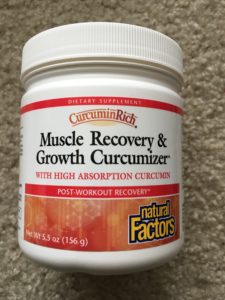
Understand this: turmeric is NOT what’s been studied. Remember that all of the studies and papers out there are testing refined curcumin compounds and NOT mere ground-up turmeric like you can buy in the spice section. Turmeric is only about 3% curcumin!! In addition, most of the studies don’t use pure curcumin because the human body can’t simply grab all the goodness out of the curcuminoids; instead, they enhance the bioavailability (making it easier for your body to grab the goods) by adding another substance. One of the more common ways to enhance the bioavailability of the ingredients in certain supplements that I have observed (by reading labels) is something called piperine, which is a substance extracted from black pepper.
Remember, you’re not a lab rat. In addition, most of the studies of curcumin have been done either in petri dishes or in animals–not in people. This makes sense, since it’s unethical to test potential medical things on human being until there is sufficient evidence that (1) it’s safe, and (2) it’s probably going to be effective. After all, if there is a treatment that will definitely cure your cancer, and something that will probably work but if it does not then you will die, it would be cruel to put you in a double-blind study instead of just giving you the treatment that is proven to work. In any case, animal studies can be useful, but human bodies do not respond the same way that mouse bodies (or any other animal bodies) do. Oh, and some of the published studies were retracted due to problems with potential data manipulation (read: lying). [Blakemore]
As with any substance, too much can cause problems. With turmeric, you’re pretty much good to eat your curries every day–remember curcumin is just one component of turmeric. If you’re scarfing down huge quantities of curcumin, like drinking the tea all day and swallowing a fistful of capsules as well, you might have some unfortunate side effects. Most things you eat too much of will cause some tummy troubles, from indigestion and nausea to vomiting and diarrhea. [Hall]
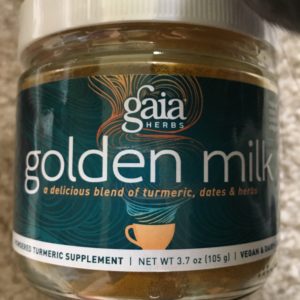
References
Harriet Hall.” Turmeric: Tasty in Curry, Questionable as Medicine.” Science-Based Medicine, June 17, 2014. Available online. This is now four years old, but is a very readable overview.
Susan J. Hewlings and Douglas S. Kalman. “Curcumin: A Review of Its’ Effects on Human Health.” Foods. 2017 Oct; 6(10): 92. PMCID: PMC5664031; PMID: 29065496. Available online. Not as old, but much more technical; great for getting your nerd on.
NCCIH (National Center for Complementary and Integrative Health), “Turmeric.” https://nccih.nih.gov/health/turmeric/ataglance.htm (This article has a bibliography at the bottom that includes many articles available online.)
Gid-MK. “The Bitter Truth about Turmeric.” January 30 2018. Medium. Super readable, mostly focused on poor (misleading) media coverage of the study on curcumin and Alzheimers.
Erin Blakemore. “What should you make of the health claims for turmeric?” August 20, 2017, Washington Post. A quick read, covers some of the potential problems with studies in curcumin, including that it might be some other compound delivering the claimed benefits.
Turmeric Taster Prize Pack!
There is ONE prize, which consists of the following items:
- natural Factors Muscle Recovery & Growth Curcumizer 5.5oz (approx. retail $22)
- gaia herbs golden milk 3.7 oz (approx. retail $15)
- Golden Goddess Turmeric Chocolate Elixir sample x2, Turmeric Chai Elixir sample x2, and turmeric infused tea sample tin
- Tea samples: yogi tea Honey Chai Turmeric Vitality, pukka turmeric glow, Republic of Tea turmeric
- Nature’s Path Golden Turmeric cereal sample x2
- youtheory Turmeric tablet samples x2
- Raw and Root Organic Tur Latte Golden Milk Infusion ($22 on Amazon)
21 Comments
i have never tried the golden milk yet so many rave….i love indian, i love milk….this could be a winner. i must investigate it!!!
I’ve never really cooked with tumeric and it sounds really beneficial. I’ve eaten it in Indian curry dishes before. Thank you for your wonderful review.
I haven’t tried turmeric really and have never heard of golden milk drinks. Sounds very beneficial.
I have tried using turmeric in some Indian recipes. My favorites are Coconut Chicken Curry and Creamy Curried Cauliflower Soup.
I love yellow curries. Funny, since as a kid I was really picky and wouldn’t eat anything with sauce on it.
I’d make it with everything that I can mostly chicken
To-date, I have not tried any umeric products or recipes but have heard great things about using tumeric.
I love cooking with spices in general. Any excuse to peruse the Penzey’s Catalogue 🙂
Not yet, but I would like to try a turmeric tonic.
There are a variety of them out there, all different types of flavors.
I would love to try the turmeric tonic
There are some fun “wellness shots” too, like two gulps of a turmeric-infused drink.
I have not tried turmeric
It’s in so many foods and drinks right now, I bet you can find an opportunity.
I have to ingest turmeric daily for arthritis in my knee- the prescription drugs that big pharma want to push on people for arthritis is crap for your body
Lots of things are “crap” for your body. I’m glad you were able to try things and find what works well for you. Kudos!
I have not tried it before. Thank you
I’ve tried the pills but no recipes.
Not everyone likes the taste in cooking (just like other flavors). I think it’s yummy!
I heard there was some great health benefits of turmeric
That seems to be the popular “word on the street,” but there isn’t a lot of evidence to reach solid conclusions yet. Some of my friends have seen a benefit, so like many things it might be worth doing a personal experiment.